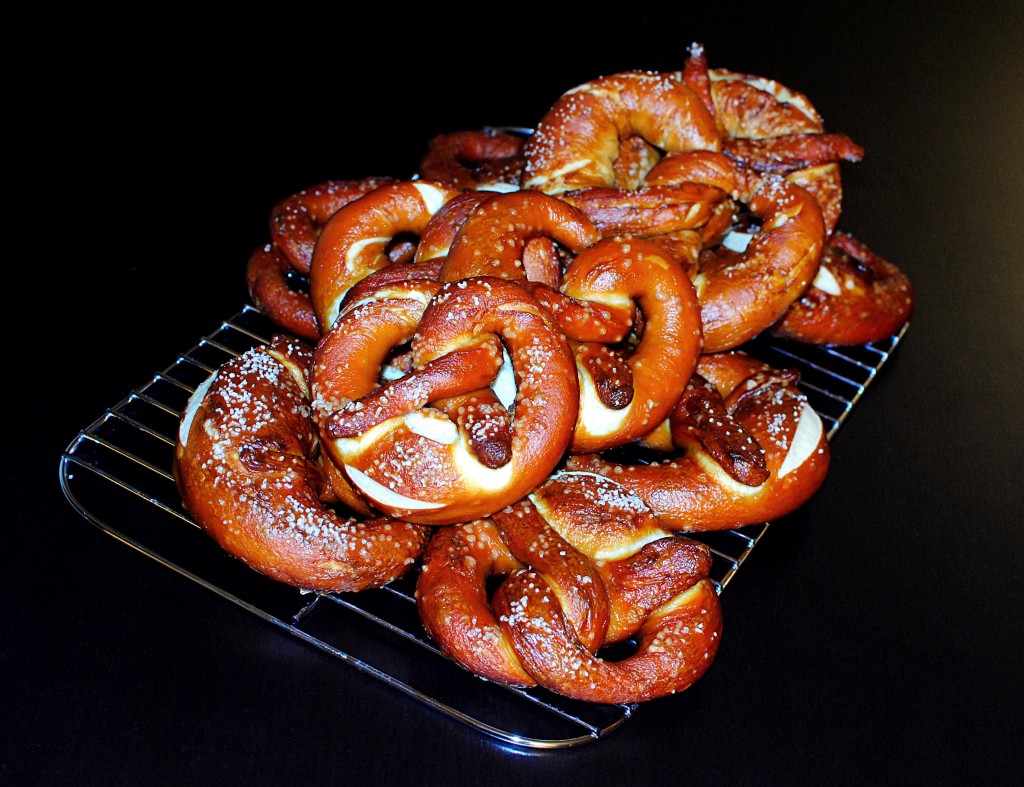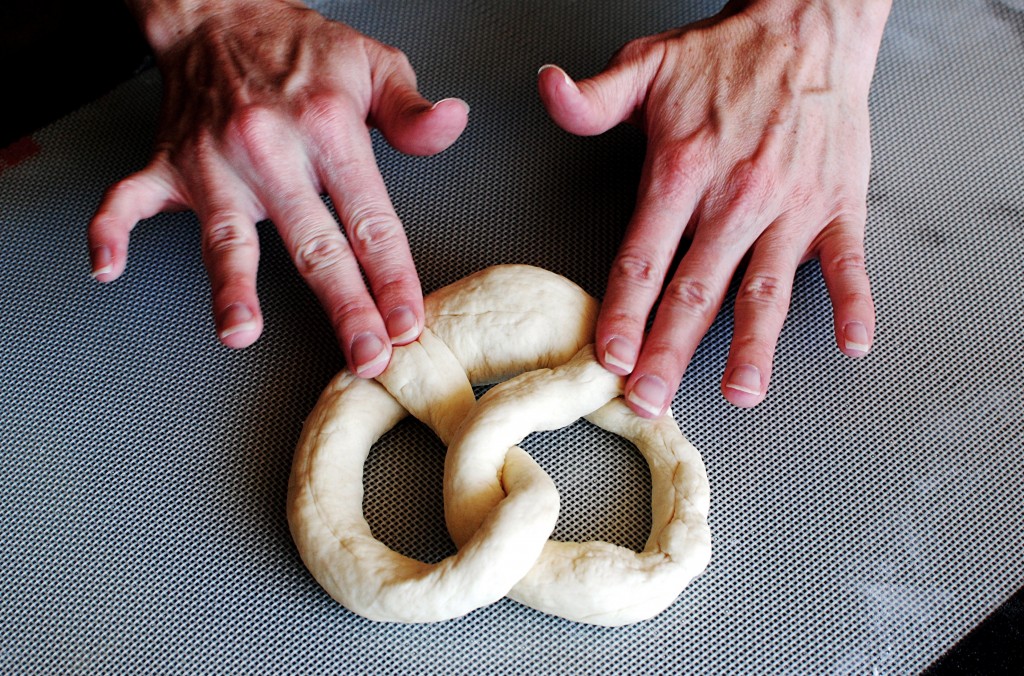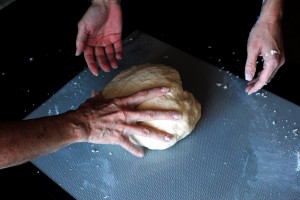 When my mom would take me to the Bäckerei (bakery) in the little town we lived in when I was just a toddler, the baker would give me one giant (to me, anyway) pretzel for each of the five fingers on my outstretched hand.
When my mom would take me to the Bäckerei (bakery) in the little town we lived in when I was just a toddler, the baker would give me one giant (to me, anyway) pretzel for each of the five fingers on my outstretched hand.
Which is really just to say: I have never not known the deliciousness of soft pretzels. They have forever been a part of my existence and to see them piled in a basket with a little jar of honey or sweet butter is to know I am home.
Before we came back to live in the States, my mom managed to convince Jakob, the baker in Öschingen (that little village where my grandmother was born) to share his recipe for the amazing soft pretzels he so dutifully baked daily for the villagers.
We have continued to make these at home over the years, mostly around Christmastime. Be forewarned: They are a little bit of an undertaking. As my mom and I were baking them together this time around, she wondered aloud, “How Jakob baked enough to meet the demands of a small village before most people were awake is beyond me!” You’ll also need to plan ahead to be sure you have all the supplies you need. But trust me, it will all be worth it when you bite into a warm German soft pretzel fresh out of the oven – something that doesn’t come easy without a transatlantic flight!
A few notes on some special ingredients and kitchen items you should know about in advance:
- Food Grade Lye. You might be able to find this at a specialty store, but I just ordered it online. I used Essential Depot Food Grade Sodium Hydroxide Lye. If cooking with lye freaks you out (yes, we know it is also used for soap and clearing clogged drains), then you can also do this with baking soda. Personally, I don’t think they come out as well, and the LA Times apparently agrees with me — that brown crusty goodness that tastes like Swabia or Bavaria just isn’t the same when you use baking soda. This is my biggest complaint with most soft pretzels sold in the States. But a few baking soda enthusiasts have posted their thoughts along with instructions on this discussion board debating lye v. baking soda (if you’d like to do your own comparison). The most important thing is that you are comfortable with what you choose to do.
- If you do use lye, you need to exercise a lot of caution and some common sense! Keep it out of the reach of children. Make sure your kitchen is well-ventilated. Open a window or turn on the ventilation fan over your stove if you have one. Add the lye to the boiling water very slowly and carefully. I thought I did a pretty good job, but I still had to run my hands under cool water to rinse off the lye from the steam and little splashes that tickled my hands as I was adding the lye to the water. Also, avoid putting your face (eyes, nasal passages) in the steam from the boiling water or the oven. Duh, right? But it’s really easy to forget when you’re eager to see how your creation is coming along! Just ask my boyfriend, who had to holler, “Watch out for the lye steam!” as I opened the oven, poised to stick my head inside to see my beautiful brown pretzels. And when you’re done, dump your lye water (slowly so it doesn’t splash) into the toilet, which will save you from having to rinse your kitchen sink extra-well to make sure the lye doesn’t linger.
- Stainless Steel Stock Pot – 6 Qt. Minimum. This is for the lye bath in which you will boil your pretzels before baking them. Do not use aluminum! And the lye bath can discolor the inside of your pot, so make sure you’re cool with that.
- Flat Slotted Pretzellifter. Germans like to smoosh words together to create a new word that perfectly describes what they mean. Thus, I give you: Pretzellifter (here are some other fun ones.) It can be a largish slotted spatula, a flattish slotted spoon/skimmer; preferably stainless steel (again, no aluminum!) or heavy-duty plastic that won’t be affected by the lye bath. Avoid using a mesh ladle – your dough will get caught in it. I used a spatula, but I think a skimmer would have worked slightly better.
OK, if you have all that, you should be ready to start!
Once you make the dough, let it rise and knead it a little more. Then cut the dough into about 12 tennis-ball sized pieces and roll out your pretzels. This part is fun! But … don’t have too much fun. There’s a happy medium between playing with the dough enough to get a good pretzel shape and overdoing it so much that it won’t roll out at all.
(P.S. – now is a good time to start heating the water and preheating the oven!)
 How to roll a pretzel, you ask? Work your dough ball into a bratwurst-size shape, turning the outside of the dough (it gets a little skin on it) into the center so it’s all the same consistency. Then roll it back and forth on a lightly floured surface starting near the middle – but avoid rolling the middle itself, because you want to preserve the nice fat pretzel “belly” – and work your hands away from each other while rolling back and forth until you get ropes with thinner ends and a bigger middle. If you let the belly roll back and forth as your hands move outward, it will pull on the dough and help you get the ends thinner.
How to roll a pretzel, you ask? Work your dough ball into a bratwurst-size shape, turning the outside of the dough (it gets a little skin on it) into the center so it’s all the same consistency. Then roll it back and forth on a lightly floured surface starting near the middle – but avoid rolling the middle itself, because you want to preserve the nice fat pretzel “belly” – and work your hands away from each other while rolling back and forth until you get ropes with thinner ends and a bigger middle. If you let the belly roll back and forth as your hands move outward, it will pull on the dough and help you get the ends thinner.
Once you have a 20- to 24-inch rope (give or take), pull the ends up, twist them around each other, then place the ends on either side of the belly and give them a gentle press. If the dough doesn’t seem to stick, dip the tip of your finger in water and use that like a glue.
When all your pretzels are rolled and shaped, it’s bath time! Carefully and slowly add the lye (just a little bit at a time!) to the boiling water. Once the bath is ready, drop 1 to 2 pretzels in (whatever will fit in the width of the pot without touching the other). Use your Pretzellifter to gently push down and make sure the entire pretzel is submerged in the bath (alternating if you have more than one in the bath). Leave in for 20 to 30 seconds or until you see a yellowish film forming all over the pretzel. Then use the Pretzellifter to lift the pretzel out of the water. Drop it on your greased and parchment-papered cookie sheets. Then, just before you stick them in the oven, take a large, sharp knife and make a thin, shallow slice across the length of the belly of all the pretzels (this is what makes that nice white dough pop through from underneath). Bake for 8 to 10 minutes or until yummy brown.
When they come out of the oven, carefully place them on a cooling rack (leave on parchment paper for a minute or two if they are too hot to pull off the paper).
Although traditionally sliced in half and buttered, I love my pretzels with a variety of accoutrement: honey, rosehip jelly and even cream cheese.
German Soft Pretzels
Recipe courtesy of Katie StrunkFor the dough:
3 1/8 cups milk
5 tablespoons butter
2 teaspoons salt
2 packages yeast (7 grams or 1/4 ounces)
8 cups flourFor the lye bath:
8 tablespoons food-grade lyeSupplies:
2 greased cookie sheets and parchment paper
Stockpot
PretzellifterMelt butter and milk in large measuring cup or glass bowl in the microwave. Let cool to lukewarm, then add yeast and salt. Give yeast a minute or two to activate.
Put 2 cups flour into a large 12-inch metal mixing bowl. Alternate mixing in the milk mixture and flour with a wooden spoon (will still be slightly sticky). By the time the dough is firm, you should still have a little flour left (1/2 to 1 cup, maybe).
Put dough on countertop and knead in remaining flour until dough is smooth and firm.Rinse the metal bowl and grease with butter (if you still have the stub of the butter stick, that works well!). Put dough in bowl, cover and let rise until double (takes about an hour or so).
After dough has risen, punch down and knead a little more. Take a large, sharp knife and cut the dough in half, then each section in half again, and then those sections into thirds. Roll them out into ropes and shape into pretzels, as described above.
Preheat oven to 475. Grease two cookie sheets and line the bottoms with parchment paper.
Fill stainless steel pot (do not use aluminum) with roughly 4 quarts of water. Make sure area is well ventilated (now is a good time to revisit my lye bath tips above!).
Bring to boil and VERY SLOWLY add 8 tablespoons lye.***UPDATE: As Jody of Old Pueblo Pretzels — one of our awesome Eaters — points out: “You never never ever add lye to boiling water! Add the lye to cool water and stir until the lye is dissolved and the water is not cloudy. Then you can heat the solution to just below a boil and turn heat down to medium low for dipping pretzels.” Or, skip the lye altogether.* Or just read more (and more) about it that we printed here.*** Give the pretzels a bath, drop them on the cookie sheets, slice the belly of the pretzels with a knife and bake in oven for 8 to 10 mintues.Remove from sheet and place on wire rack to cool. Makes about 12.




I am screwing up my courage to try these! But of course, I have to know — what happens if you use aluminum?! Please tell me so I don’t have to flout your advice to find out!
If only you had asked “Why can’t you use aluminum?” … then my knowledge prior to just now would have sufficed to answer: “because mom said so.” (Isn’t that always a good answer?). But my best guess, confirmed through science forums found via Google search, is that there is some reaction that leaches the aluminum into the water. Lye in water will actually dissolve aluminum! Aluminum in food, bad! Nerdier explanation on a bulletin board “why lye and aluminum shouldn’t be mixed” here: http://www.chemicalforums.com/index.php?topic=208.0. Funny enough, the first answer quotes a German web site – ha!
You may want to rewrite the part about boiling water and then adding lye? You never never ever add lye to boiling water! That’s just basic chemistry. Always add the lye to cool water and stir until the lye is dissolved and the water is not cloudy. Then you can heat the solution to just below a boil and turn heat down to medium low for dipping pretzels.
Jody — Thank you for this info. We will make the updates.
Author and recipe holder here. For thirty-plus years we have been adding the lye to the boiling water – an instruction from the baker in Germany who gave us the recipe – and have never had an issue. As always, you should follow the instructions and exercise caution. Not sure if it changes the chemistry (and thus the taste) to add the lye when the water is cooler, but I have yet to buy a pretzel stateside that tastes as authentically German as these, and the lye bath seems to be the secret.
Hey, Emily! Thank you for the added details!